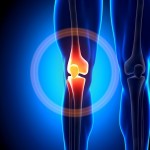 Your knee is the largest joint in your body and one of the most complex. Any injury to your knee can threaten its stability, which makes your entire body more vulnerable. An injury to a single knee component can cause it to give out and possibly injure another part of your body in the process.
Your knee is the largest joint in your body and one of the most complex. Any injury to your knee can threaten its stability, which makes your entire body more vulnerable. An injury to a single knee component can cause it to give out and possibly injure another part of your body in the process.
Knee Specialist in Orange County
Obtaining immediate medical attention for a knee injury is vital to preventing additional damage from occurring. It gives you the best possibility to returning to your normal activities as soon as possible.
Anatomy of the Knee
The structure of your knee is comprised of four main parts:
1. Bones that provide stability, flexibility, and strength to the knee.
- Tibia – known as the shin bone, two pieces of cartilage reside on the flat areas on the tibia
- Fibula – a thin bone in your lower leg that runs along the tibia
- Femur – known as the thigh bone, the femur is the strongest, longest and largest bone in your body
- Patella – triangular, flat bone that moves when your leg moves. The patella protects the knee joint and relieves friction between muscles and bones when bending or straightening your knee.
2. Cartilage acts as a shock absorber within your knee. It’s a stiff, but flexible tissue that does not heal well on its own.
- Medial meniscus – cartilage that is attached to the tibia on the inside of your knee
- Lateral meniscus – cartilage that is attached to the tibia on the outside of your knee
- Articular cartilage – cartilage that covers the ends of the femur and tibia and the back surface of the patella. With the aid of synovial fluid, the cartilage is kept smooth and slippery to reduce friction on the bones.
3. Ligaments connect bones together and help stabilize the knee.
- Medial Collateral Ligament (MCL) – attaches the medial side of the tibia to the medial side of the femur and controls your knee’s sideways motion
- Lateral Collateral Ligament (LCL) – attaches the lateral side of the fibula to the lateral side of the femur and controls your knee’s sideways motion
- Anterior Cruciate Ligament (ACL) – attaches the femur and tibia to the center of your knee and controls rotation and forward motion
- Posterior Cruciate Ligament (PCL) – attaches the femur to the tibia and controls backwards motion
- Patellar ligament – attaches the tibia to the kneecap
4. Tendons connect muscles to the bone and work to stabilize the knee.
- Quadriceps – connects the quadriceps muscles to the kneecap and allows for straightening the knee
- Patellar – technically considered a ligament, this tendon connects the kneecap to the tibia
Top Knee Specialist in Orange County
Many things can go wrong with your knee. For knee injuries, you want a top knee specialist. Dr. Howard Marans is a fellowship-trained knee specialist in Orange County with over 20 years of experience in repairing knee injuries. Please click below to schedule your consultation or call us at 714.979.8981.


